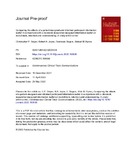Comparing the effects of a patient-designed-and-informed participant information leaflet in comparison with a standard, researcher-designed information leaflet on recruitment, retention and understanding: A study-within-a-trial
Date
2022-06-09Author
Dwyer, Christopher P.
Joyce, Robert A.
Rogers, Fionnuala
Hynes, Sinéad M.
Metadata
Show full item recordUsage
This item's downloads: 37 (view details)
Recommended Citation
Dwyer, Christopher P., Joyce, Robert A., Rogers, Fionnuala, & Hynes, Sinéad M. (2022). Comparing the effects of a patient-designed-and-informed participant information leaflet in comparison with a standard, researcher-designed information leaflet on recruitment, retention and understanding: A study-within-a-trial. Contemporary Clinical Trials Communications, 28, 100936. doi: https://doi.org/10.1016/j.conctc.2022.100936
Published Version
Abstract
Background and aim
The process of trial recruitment is vital, given its impact on resources, statistical power and the validity of findings. A participant information leaflet (PIL) is often the initial and primary source of information engaged by potential participants during recruitment. Research suggests that a variety of manipulations to a PIL can be made during its development to enhance understanding, readability and accessibility. In light of this, PIL-design led by Public and Patient Involvement (PPI) may also yield positive effects in this respect, as well as consent and retention. This study-within-a-trial (SWAT) compared the effects of a PPI-developed PIL with a standard, researcher-developed PIL on rates of consent, retention, decision certainty, understanding, readability, accessibility, likeability and decision to consent.
Method
This SWAT used a double-blind, two-armed randomised design. The SWAT was conducted within a host trial of cognitive rehabilitation in multiple sclerosis.
Results
A total of 234 people expressed interest in the trial, of which 94 were retained at 6-month follow up. Results revealed no effects on levels of consent and retention between the two PIL groups.
Conclusions
These null effects provide interesting points of discussion and important implications for not only future research on PILs, but also for future research that involves recruitment to health-related interventions.


